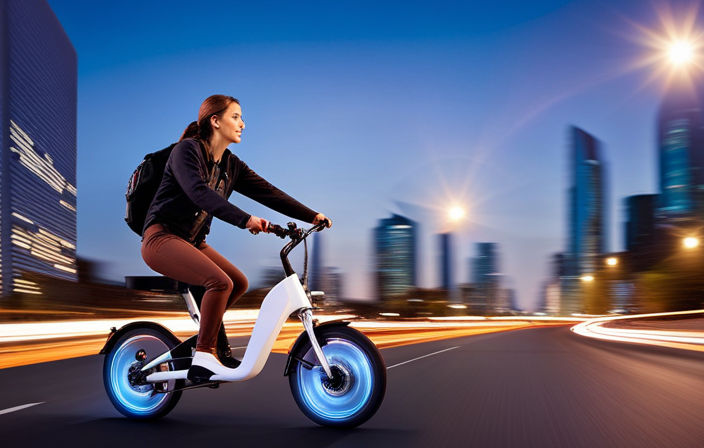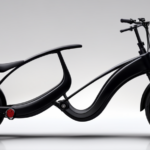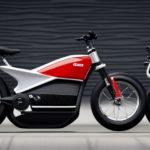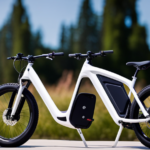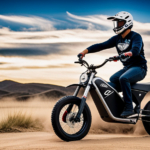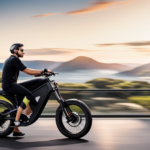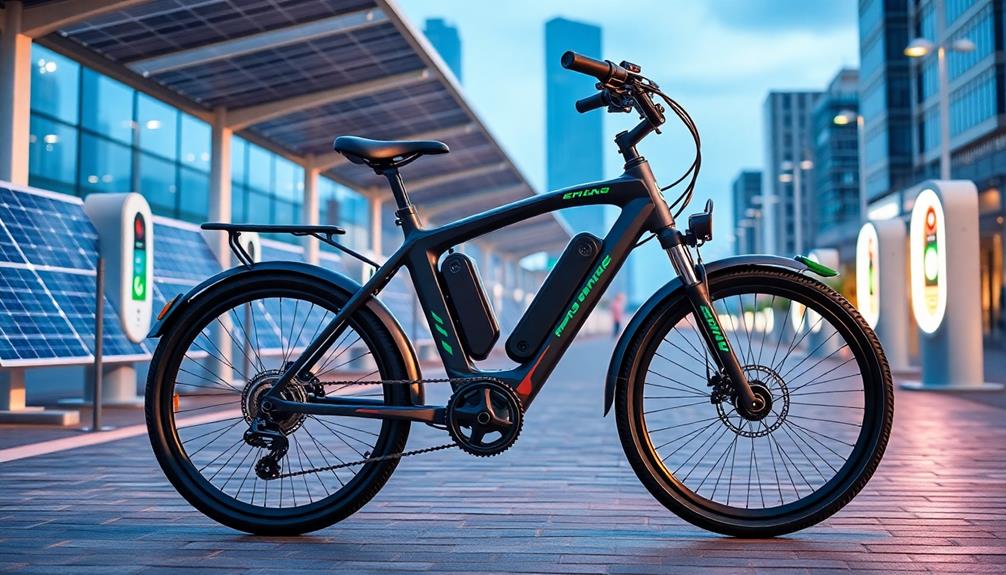Imagine the exhilaration of soaring through the streets on a 36v 800w hub electric bike. With its impressive power and speed potential, this two-wheeled marvel promises an electrifying ride.
In this article, we will explore the factors that determine the top speed of these bikes, from the voltage and wattage to external influences.
We will also delve into safety considerations, real-life experiences, and legal restrictions.
So fasten your helmet and prepare to uncover the thrilling world of 36v 800w hub electric bikes.
Key Takeaways
- Electric bikes can reach speeds of up to 25 mph
- Riders appreciate the smooth and comfortable ride
- Enhanced efficiency allows for longer distances without fatigue
- Battery life is impressive, reducing the need for frequent recharging
Overview of 36v 800w Hub Electric Bikes
A 36v 800w hub electric bike can reach impressive speeds. Understanding motor power is key to understanding the capabilities of these bikes. The 36v refers to the voltage of the battery, while the 800w indicates the power output of the motor. The higher the wattage, the more powerful the motor and the faster the bike can go.
Hub motors, which are commonly used in electric bikes, have several advantages. They are quiet, efficient, and provide a smooth ride. Additionally, hub motors are located in the wheel hub, which means they can provide direct power to the wheel, resulting in better control and acceleration.
With this understanding of the power and speed potential, let’s delve into the different factors that determine how fast a 36v 800w hub electric bike can go.
Understanding the Power and Speed Potential
To understand the power and speed potential, you need to consider the voltage and wattage of the 36v 800w hub electric bike.
The voltage of 36v indicates the strength of the electrical current flowing through the motor. The higher the voltage, the more power the motor can deliver.
Similarly, the wattage of 800w measures the rate at which the motor can convert electrical energy into mechanical energy. This combination of voltage and wattage determines the power efficiency and motor performance of the bike.
A 36v 800w hub electric bike can provide a decent amount of power and speed, allowing you to reach higher velocities compared to lower voltage or wattage models. However, it’s important to note that there are other factors affecting the top speed, such as terrain, rider weight, and aerodynamics.
Factors Affecting the Top Speed
When discussing the factors affecting the top speed of an electric bike, it is important to consider the terrain and road conditions that the bike will be ridden on. Steep inclines or rough surfaces can significantly impact the speed at which the bike can travel.
Additionally, the rider’s weight and riding style play a role in determining the top speed. A heavier rider or a rider who prefers a more aggressive style of riding may experience a decrease in speed.
Lastly, the battery life and charge level of the bike’s battery will also affect the top speed. A fully charged battery will provide more power and allow for a higher top speed, while a low battery level will result in reduced speed.
Terrain and Road Conditions
On different terrains and road conditions, you’ll experience varying speeds with your 36v 800w hub electric bike. The performance of your bike off-road will depend on factors like the quality of the suspension, the size of the tires, and the power delivery of the motor.
Additionally, weather conditions can greatly impact your bike’s performance. Riding through wet or muddy terrain can reduce traction and make it more challenging to maintain high speeds. Similarly, strong headwinds can slow you down and make it harder to reach top speed. It’s important to consider these factors when planning your rides and adjust your expectations accordingly.
Moving on to the next section about rider weight and riding style, these factors also play a significant role in determining the speed of your electric bike.
Rider Weight and Riding Style
Your weight and riding style greatly affect how your 36v 800w hub electric bike performs. The impact of rider weight on electric bike speed is significant. Heavier riders may experience a decrease in top speed and acceleration compared to lighter riders. This is because the motor has to work harder to propel the bike forward with the additional weight.
On the other hand, lighter riders may experience faster speeds and quicker acceleration. Additionally, riding style also plays a role in the performance of electric bikes. Aggressive riders who frequently accelerate and brake may experience a decrease in battery life and overall performance compared to riders who maintain a steady pace.
It is important to consider these factors when choosing an electric bike and adjusting your riding style. Transitioning into the subsequent section about battery life and charge, it is essential to understand how these factors interact to optimize your riding experience.
Battery Life and Charge
The longevity of the battery and its charging capability greatly impact the overall performance of your 36v 800w hub e-bike. It is important to consider the battery capacity and charging time when evaluating the battery life and charge of your electric bike. Here are some key points to keep in mind:
-
Battery capacity: The capacity of the battery determines how much energy it can store. A higher capacity battery will provide a longer ride time before needing to be recharged.
-
Charging time: The charging time refers to how long it takes to fully charge the battery. This can vary depending on the charger used and the battery’s capacity. It is important to choose a charger that is compatible with your e-bike’s battery to ensure efficient charging.
-
Efficient charging: To maximize the battery life and charge, it is recommended to follow the manufacturer’s guidelines for charging. Avoid overcharging or undercharging the battery, as this can affect its performance and lifespan.
Considering these factors will help you optimize the battery life and charge of your 36v 800w hub e-bike. Understanding the battery’s capacity and charging time will ensure that you can enjoy a reliable and efficient ride.
In the next section, we will discuss the typical speed range of 36v 800w hub electric bikes.
Typical Speed Range of 36v 800w Hub Electric Bikes
The typical speed range of a 36v 800w hub electric bike is around 20-25 miles per hour. With its maximum speed reaching up to 25 mph, this type of electric bike offers a decent level of acceleration capability.
The powerful 800w hub motor provides ample torque to propel the bike forward swiftly, allowing riders to reach their desired speed quickly. This increased acceleration capability is especially beneficial when navigating through traffic or climbing steep hills.
However, it is important to consider safety considerations at higher speeds. Riding at faster speeds requires increased attention and caution, as it can be more challenging to maneuver and react to unexpected obstacles.
Therefore, it is essential to stay vigilant, wear appropriate safety gear, and adhere to traffic regulations to ensure a safe and enjoyable riding experience.
Safety Considerations at Higher Speeds
Be cautious and maintain control while riding at higher speeds on your electric bike. Safety should always be a top priority when pushing the limits of your bike’s speed capabilities.
To ensure your safety, it is crucial to wear appropriate safety gear such as a helmet, knee and elbow pads, and even protective clothing.
Additionally, regular maintenance checks are essential to keep your bike running smoothly at high speeds. Pay close attention to the condition of your brakes, tires, and suspension system, as these components play a crucial role in maintaining control and stopping power.
By prioritizing safety gear and maintenance requirements, you can enjoy the thrill of higher speeds while minimizing the risks.
Now, let’s delve into some tips for maximizing speed and performance.
Tips for Maximizing Speed and Performance
As we discussed earlier, safety is paramount when riding at higher speeds on an electric bike. Now, let’s focus on some tips to maximize speed and performance.
-
Optimize your acceleration: To achieve maximum speed, ensure your bike’s motor is properly calibrated and the battery is fully charged. This will provide ample power for quick acceleration.
-
Enhance aerodynamics: Reduce wind resistance by adopting a streamlined riding position, tucking in your elbows, and keeping your head low. Additionally, consider adding aerodynamic accessories like a fairing or aero bars.
-
Choose the right tires: Opt for narrow, low-profile tires with minimal rolling resistance. This will reduce friction and improve the bike’s overall speed.
-
Maintain your bike: Regularly check and maintain your bike’s components, such as the chain, brakes, and gears. Proper maintenance ensures optimal performance and efficiency.
By following these tips, you can maximize your bike’s speed and performance.
Now, let’s delve into other factors to consider when choosing an electric bike.
Other Factors to Consider When Choosing an Electric Bike
When considering an electric bike, it’s important to take into account various other factors.
One of these factors is electric bike maintenance. It’s crucial to properly maintain your electric bike to ensure its longevity and optimal performance. This includes regularly checking and lubricating the chain, keeping the battery charged, and cleaning the bike to prevent dirt and debris from affecting its mechanisms.
Another factor to consider is choosing the right tire size. The tire size can greatly impact the speed and performance of the electric bike. Smaller tires provide quicker acceleration and better maneuverability, while larger tires offer more stability and a smoother ride. It’s important to choose a tire size that suits your specific needs and preferences.
Considering these factors will help you make an informed decision when choosing an electric bike. Speaking of which, let’s move on to the next section about testimonials and real-life experiences.
Testimonials and Real-Life Experiences
Testimonials from real-life riders provide valuable insights into the performance and satisfaction of electric bikes. Here are three key takeaways from their experiences:
-
Increased Speed: Many riders have reported that their 36V 800W hub electric bikes can reach speeds of up to 25 mph, allowing them to cover longer distances in a shorter amount of time.
-
Smooth Ride: Testimonials consistently highlight the smooth and comfortable ride offered by these electric bikes. The powerful motor and sturdy construction contribute to a stable and enjoyable riding experience.
-
Enhanced Efficiency: Riders have praised the efficiency of their electric bikes, noting that they can travel longer distances without feeling fatigued. The battery life on these bikes is impressive, allowing for extended rides without the need for frequent recharging.
These testimonials and real-life experiences demonstrate the impressive performance and overall satisfaction that can be achieved with a 36V 800W hub electric bike.
Transitioning into the subsequent section about legal restrictions and regulations on electric bike speed, it is important to note that while these bikes can reach high speeds, there are legal limitations in place to ensure safety on the roads.
Legal Restrictions and Regulations on Electric Bike Speed
You should be aware of the legal restrictions and regulations that govern the speed of electric bikes. Electric bikes are becoming increasingly popular, and as a result, there have been discussions about their impact on traffic flow.
Currently, most jurisdictions set a maximum speed limit for electric bikes, typically around 20 mph (32 km/h). This is to ensure the safety of both the rider and other road users. However, there have been debates regarding the potential changes in speed regulations for electric bikes.
Some argue that increasing the speed limit could improve traffic flow, while others worry about the potential risks involved. It is important to stay informed about any changes in the regulations surrounding electric bike speed, as they may impact your riding experience.
In conclusion, it is crucial to be aware of the legal restrictions and potential changes in speed regulations for electric bikes.
Conclusion and Final Thoughts
In conclusion, it’s important to consider the legal restrictions and potential changes in speed regulations for electric bikes.
Maximizing efficiency is crucial in achieving the highest speed possible with a 36V 800W hub electric bike.
Weather conditions can have a significant impact on the bike’s performance and speed. Wind resistance, for instance, can cause a decrease in speed, while a tailwind can increase it. Additionally, riding in extreme weather conditions, such as heavy rain or snow, can also affect the bike’s traction and stability, ultimately affecting the speed.
It is essential to check local laws and regulations regarding electric bike speed limits to ensure compliance. Moreover, keeping an eye on any potential changes in speed regulations is crucial to stay up to date with the legal requirements for electric bikes.
Frequently Asked Questions
Can I modify my 36v 800w hub electric bike to make it go faster?
Yes, it is possible to modify a 36v 800w hub electric bike to increase its speed. By optimizing its performance through modifications such as upgrading the motor or adjusting the controller settings, you can achieve a faster riding experience.
Are there any safety measures I should take when riding at the top speed of a 36v 800w hub electric bike?
When riding at top speed on a 36v 800w hub electric bike, it is crucial to prioritize safety precautions. Strictly adhere to speed limitations and wear appropriate protective gear to mitigate potential risks and ensure a secure riding experience.
How does the weight of the rider affect the top speed of a 36v 800w hub electric bike?
The weight of the rider affects the acceleration of a 36v 800w hub electric bike. Heavier riders may experience slower acceleration. Additionally, the rider’s weight can impact the battery life, causing it to drain more quickly.
Are there any specific maintenance requirements for a 36v 800w hub electric bike to ensure optimal speed and performance?
To ensure optimal performance of a 36v 800w hub electric bike, regular maintenance is crucial. This includes checking and maintaining the battery, motor, brakes, gears, and tires, as well as cleaning and lubricating components.
What are the differences in speed between a 36v 800w hub electric bike and other types of electric bikes?
"The differences in speed between a 36v 800w hub electric bike and other types of electric bikes can be attributed to variations in acceleration and the impact of terrain on speed."
Conclusion
In conclusion, the speed potential of a 36v 800w hub electric bike can reach up to 28 miles per hour. This statistic highlights the impressive capability of these bikes to provide a fast and efficient mode of transportation.
However, it is important to note that the actual top speed can be influenced by various factors such as rider weight, terrain, and wind resistance. It is crucial to prioritize safety and adhere to legal restrictions and regulations when operating these bikes at higher speeds.
Choosing the right electric bike involves considering factors beyond just speed, such as battery life, comfort, and durability. Ultimately, the decision should be based on individual preferences and needs.


